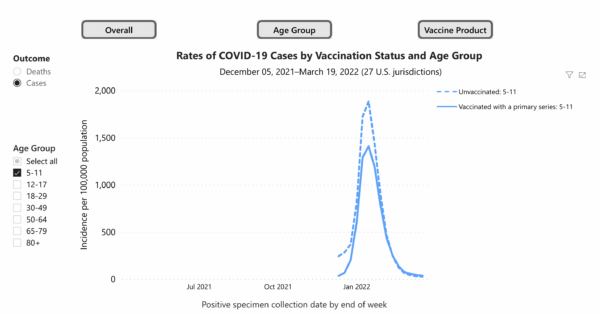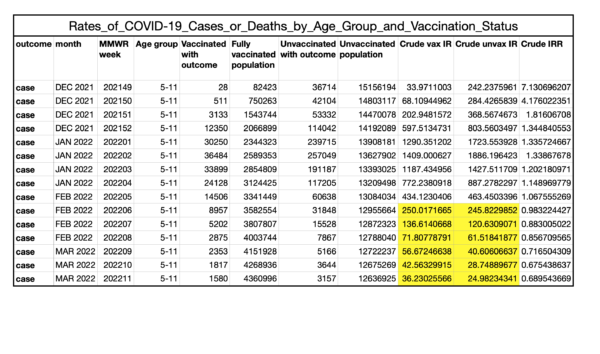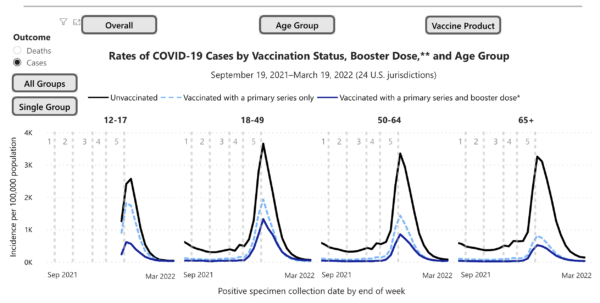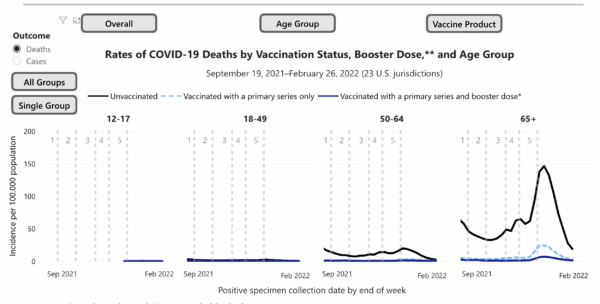Higher COVID-19 Infection Rates Among Vaccinated Children Than Unvaccinated, CDC Data Show
According to data released by the Centers for Disease Control and Prevention (CDC), higher COVID-19 case rates have been recorded among fully vaccinated children than unvaccinated in the age group 5-11 since February.
On Feb. 12, CDC reported a weekly case rate of 250.02 per 10,000 population in fully vaccinated children aged 5-11, compared to 245.82 for unvaccinated children in the same age group.
That’s the first time CDC recorded a higher case rate among fully vaccinated young children since data was first collected in December 2021. It remains for the following weeks till the third week of March, the latest week with available data.

 COVID-19 case rates between fully vaccinated and unvaccinated children aged 5-11. (CDC/Screenshot via The Epoch Times)
COVID-19 case rates between fully vaccinated and unvaccinated children aged 5-11. (CDC/Screenshot via The Epoch Times)
 Data about COVID-19 cases between vaccinated and unvaccinated children aged 5-11. “Crude vax/unvax IR” means the unadjusted incidence rate of the corresponding outcome among the population vaccinated/unvaccinated (per 100,000 population). “Crude IRR” means unadjusted incidence rate ratio (unvaccinated : vaccinated). (Data from CDC. Highlights made by The Epoch Times)
Data about COVID-19 cases between vaccinated and unvaccinated children aged 5-11. “Crude vax/unvax IR” means the unadjusted incidence rate of the corresponding outcome among the population vaccinated/unvaccinated (per 100,000 population). “Crude IRR” means unadjusted incidence rate ratio (unvaccinated : vaccinated). (Data from CDC. Highlights made by The Epoch Times)Children aged 5–11 years became eligible for COVID-19 vaccination on Nov. 2, 2021. There are about 28 million children in this age group in the nation.
Currently, about 28.8 percent of children in this age group have been fully vaccinated, according to Mayo Clinic.
CDC’s data also show the gap in rates of cases between fully vaccinated and unvaccinated has become increasingly smaller among other age groups. The death rates show the same trend between fully vaccinated and unvaccinated for people above 50. For people under 50 years old, the death rates have not much difference since the rollout of the vaccine.

 Rates of COVID-19 cases by vaccination status, booster dose, and age group. (CDC/Screenshot via The Epoch Times)
Rates of COVID-19 cases by vaccination status, booster dose, and age group. (CDC/Screenshot via The Epoch Times)
 Rates of COVID-19 deaths by vaccination status and age group. (CDC/Screenshot via The Epoch Times)
Rates of COVID-19 deaths by vaccination status and age group. (CDC/Screenshot via The Epoch Times)The data show that the COVID-19 vaccines have a “negligible effect” on people, said Dr. Peter McCullough, a renowned cardiologist and epidemiologist.
“With these results in hand, it is clear the vaccines are having a negligible effect in populations,” McCullough told The Epoch Times via email. “Given the overall poor safety profile and lack of any assurances on long-term safety, Americans should be cautious in considering additional injections of these products.”

 Dr. Peter McCullough in New York on Dec. 24, 2021. (Jack Wang/The Epoch Times)
Dr. Peter McCullough in New York on Dec. 24, 2021. (Jack Wang/The Epoch Times)CDC responded that several factors contribute to this phenomenon in the age group 5-11.
“Several factors likely affect crude case rates by vaccination and booster dose status, making interpretation of recent trends difficult,” Jasmine Reed, a CDC spokesperson, told The Epoch Times via email.
“Limitations include higher prevalence of previous infection among the unvaccinated and un-boosted groups; difficulty in accounting for time since vaccination and waning protection; and possible differences in testing practices (such as at-home tests) and prevention behaviors by age and vaccination status. These limitations appear to have less impact on the death rates presented here.”
Reed also directed The Epoch Times to a study published by CDC in March, showing Pfizer’s vaccine reduced the Omicron infection among children and adolescents aged 5-15.
Pfizer’s vaccine is the only COVID-19 vaccine that can be administered to the age group 5-17. Pfizer hasn’t responded to a request for comment.
“CDC is assessing whether to continue using these case rate data to provide preliminary information on vaccine impact,” Reed added.
On May 13, a study published by the Journal of the American Medical Association found that Pfizer’s COVID-19 vaccine turned negatively effective after five months.
The protection also waned considerably against hospitalization over time, the study found. The authors said one way to combat the negative effectiveness was to get a booster dose.
McCullough said most non-randomized studies attempting to estimate vaccine efficacy (VE) had some “common flaws”, including no accounting for baseline prior COVID-19 infection; no reporting for currently boostered within a 6-month time window; and no adjudication of hospitalization or death due to COVID-19 or other conditions.
“As a result, most studies of COVID-19 VE have biases towards overestimating any clinical benefit of vaccination,” said McCullough.
The Food and Drug Administration (FDA) is expected to authorize a booster shot of the Pfizer vaccine for children 5-11 as early as Tuesday, The New York Times reported.
Last month, Moderna requested an emergency use authorization for its COVID-19 vaccine for children 6 months to 6 years of age. As the FDA postponed its decision in February on whether to authorize its COVID-19 vaccine for children six months to four years old, Pfizer is now working on data for a three-dose regimen.
Zachary Stieber contributed to this report.



